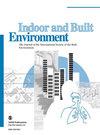室内环境与建筑物供暖、通风和空调能耗多输出预测模型的系统性审查
IF 3.2
3区 工程技术
Q2 CONSTRUCTION & BUILDING TECHNOLOGY
引用次数: 0
摘要
供暖、通风和空调(HVAC)系统会对室内环境质量产生重大影响,尤其是在热舒适度和室内空气质量方面。实现高质量的室内环境对暖通空调系统的能耗提出了挑战。因此,平衡热舒适度、室内空气质量(IAQ)和能源消耗成为一项具有挑战性的任务。目前,室内环境预测方法被认为是解决这一问题的有效方案。然而,已发表的文献通常集中在热舒适度、空气质量或能耗等单一方面,多方面的预测方法并不多见。本研究回顾了过去十年间的研究,这些研究采用机器学习方法,通过单独和多输出预测模型来预测室内环境和暖通空调能耗。独立预测模型侧重于暖通空调系统对室内环境的影响,而多输出模型则考虑了各种输出的相互作用。本文深入介绍了机器学习预测模型的工作流程,详细说明了每个研究目标的数据收集、特征选择和模型优化。文章对不同预测目标的数据收集方法、机器学习算法和不同预测模型的验证方法进行了系统评估。这篇综述强调了数据管理、模型开发和验证的复杂性,丰富了室内环境质量优化的知识库。本文章由计算机程序翻译,如有差异,请以英文原文为准。
A systematic review of multi-output prediction model for indoor environment and heating, ventilation, and air conditioning energy consumption in buildings
Heating, ventilation and air conditioning (HVAC) systems could significantly impact indoor environmental quality, particularly in terms of thermal comfort and indoor air quality. Achieving a high-quality indoor environment poses challenges to the energy consumption of HVAC systems. Thus, balancing thermal comfort, indoor air quality (IAQ) and energy consumption becomes a challenging task. Currently, indoor environment prediction methods are considered effective solutions to address this issue. However, the published literature usually concentrates on single aspects like thermal comfort, air quality or energy consumption, with multi-aspect prediction methods being rare. The present work reviews research spanning the last decade that employs machine learning methods for predicting indoor environments and HVAC energy consumption through separate and multi-output predictive models. Separate predictive models focus on HVAC systems’ impact on the indoor environment, while multi-output models consider the interplay of various outputs. This article gives a thorough insight into machine learning prediction models’ workflow, detailing data collection, feature selection and model optimization for each research goal. A systematic assessment of methods for data collection of diverse prediction targets, machine learning algorithms and validation approaches for different prediction models is presented. This review highlights the complexities of data management, model development and validation, enriching the knowledge base in indoor environmental quality optimization.
求助全文
通过发布文献求助,成功后即可免费获取论文全文。
去求助
来源期刊

Indoor and Built Environment
环境科学-工程:环境
CiteScore
6.40
自引率
25.00%
发文量
130
审稿时长
2.6 months
期刊介绍:
Indoor and Built Environment publishes reports on any topic pertaining to the quality of the indoor and built environment, and how these might effect the health, performance, efficiency and comfort of persons living or working there. Topics range from urban infrastructure, design of buildings, and materials used to laboratory studies including building airflow simulations and health effects. This journal is a member of the Committee on Publication Ethics (COPE).
 求助内容:
求助内容: 应助结果提醒方式:
应助结果提醒方式:


